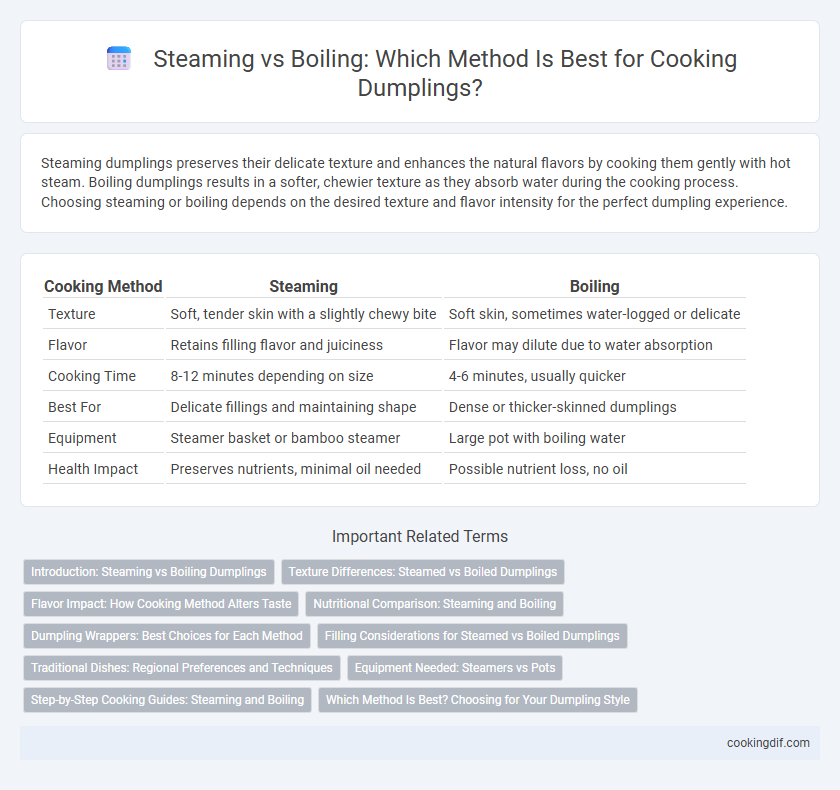Steaming dumplings preserves their delicate texture and enhances the natural flavors by cooking them gently with hot steam. Boiling dumplings results in a softer, chewier texture as they absorb water during the cooking process. Choosing steaming or boiling depends on the desired texture and flavor intensity for the perfect dumpling experience.
Table of Comparison
| Cooking Method | Steaming | Boiling |
|---|---|---|
| Texture | Soft, tender skin with a slightly chewy bite | Soft skin, sometimes water-logged or delicate |
| Flavor | Retains filling flavor and juiciness | Flavor may dilute due to water absorption |
| Cooking Time | 8-12 minutes depending on size | 4-6 minutes, usually quicker |
| Best For | Delicate fillings and maintaining shape | Dense or thicker-skinned dumplings |
| Equipment | Steamer basket or bamboo steamer | Large pot with boiling water |
| Health Impact | Preserves nutrients, minimal oil needed | Possible nutrient loss, no oil |
Introduction: Steaming vs Boiling Dumplings
Steaming dumplings preserves their delicate texture by cooking them gently with moist heat, which helps retain juiciness and flavor. Boiling dumplings cooks them quickly in water, resulting in a tender exterior and plump filling but may cause some flavor loss in the broth. Choosing between steaming and boiling depends on the desired texture and taste profile for the dumplings.
Texture Differences: Steamed vs Boiled Dumplings
Steaming dumplings results in a tender yet slightly chewy texture with a moist surface, preserving the filling's juiciness and enhancing the dough's elasticity. Boiling dumplings produces a softer, more delicate wrapper that is fully hydrated but can become waterlogged, sometimes causing the dough to lose its firmness. Texture differences between steamed and boiled dumplings significantly influence the eating experience, with steaming offering a more resilient bite and boiling delivering a melt-in-the-mouth softness.
Flavor Impact: How Cooking Method Alters Taste
Steaming dumplings preserves the delicate filling flavors and natural juices, resulting in a tender, moist bite with a subtle aroma. Boiling infuses dumplings with the surrounding water, which can dilute some of the filling's intensity but enhances a softer, chewier texture. The choice between steaming and boiling significantly impacts the overall taste experience, with steaming emphasizing purity of flavor and boiling offering a mild, comfort-food profile.
Nutritional Comparison: Steaming and Boiling
Steaming dumplings retains more nutrients such as vitamins B and C, as the gentle heat preserves heat-sensitive compounds better than boiling. Boiling can cause water-soluble nutrients, like vitamin C and certain antioxidants, to leach out into the cooking water, reducing the overall nutritional value. Both methods maintain protein and carbohydrate content, but steaming offers a healthier cooking option by minimizing nutrient loss and avoiding water absorption that can dilute dumpling flavors.
Dumpling Wrappers: Best Choices for Each Method
Dumpling wrappers for steaming are typically thicker and made with higher protein flour to maintain structure and absorb moisture without dissolving. For boiling, thinner wrappers with lower protein content soften quickly and create a tender, delicate texture. Choosing the right wrapper type enhances dumpling integrity and texture during cooking.
Filling Considerations for Steamed vs Boiled Dumplings
Steamed dumplings retain more moisture in delicate fillings like seafood or vegetables, preventing them from becoming soggy, while boiling can enhance the flavor infusion in heartier meat or pork-based fillings. The steaming process preserves the texture and integrity of fragile ingredients, making it ideal for light and tender fillings. Boiling allows the dumpling wrapper to absorb broth flavors, which complements robust, dense fillings but may cause delicate mixtures to lose firmness.
Traditional Dishes: Regional Preferences and Techniques
Steaming dumplings is a favored technique in Northern China, preserving the delicate texture and enhancing the natural flavors of fillings in traditional dishes like jiaozi. Boiling dumplings, commonly practiced in Southern China, yields a tender, slightly chewy wrapper ideal for dishes such as wontons and shuijiao. Each method reflects regional preferences rooted in historical cooking practices, impacting texture, taste, and overall dining experience.
Equipment Needed: Steamers vs Pots
Steaming dumplings requires specialized equipment such as bamboo steamers, metal steam racks, or electric steamers designed to evenly circulate steam, preventing sogginess and preserving texture. Boiling dumplings demands a large pot filled with water, often supplemented by a slotted spoon or spider strainer for easy removal without tearing the dumpling skin. Both methods influence cooking time and moisture retention, but the choice of equipment directly impacts the dumpling's final taste and texture quality.
Step-by-Step Cooking Guides: Steaming and Boiling
Steaming dumplings requires placing them in a bamboo or metal steamer lined with parchment paper or cabbage leaves to prevent sticking, then cooking over boiling water for 10-15 minutes until the wrappers turn translucent. Boiling involves dropping dumplings into rapidly boiling water, gently stirring to prevent sticking, and cooking for 6-8 minutes or until they float, indicating doneness. Both methods ensure the filling reaches a safe internal temperature of 165degF (74degC) for optimal taste and food safety.
Which Method Is Best? Choosing for Your Dumpling Style
Steaming dumplings preserves their delicate texture and enhances the natural flavors, making it ideal for thin-skinned varieties like xiao long bao or har gow. Boiling dumplings results in a softer, chewier wrapper that absorbs the broth's taste, suited for heartier fillings such as pork or vegetable. Selecting the best cooking method depends on the dumpling style and desired texture, with steaming preferred for light, tender dumplings and boiling favored for dense, flavorful ones.
Steaming vs Boiling for dumpling cooking Infographic

 cookingdif.com
cookingdif.com